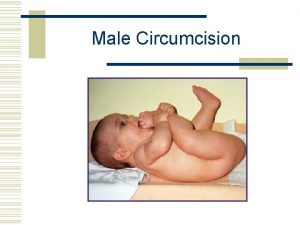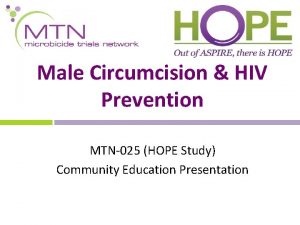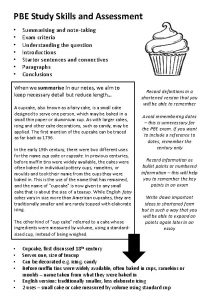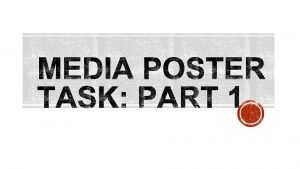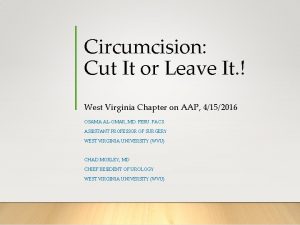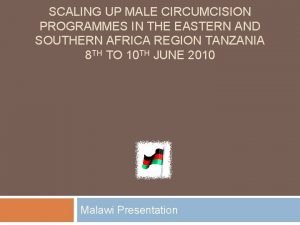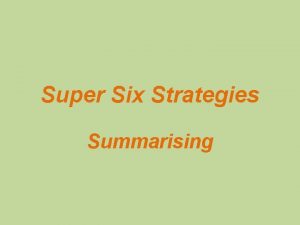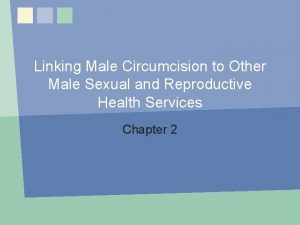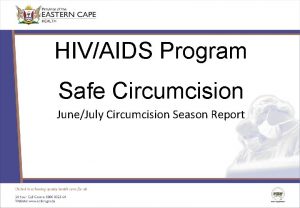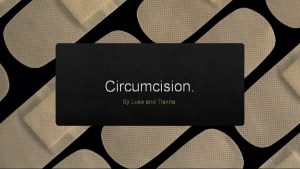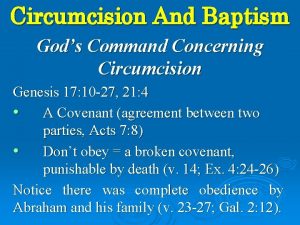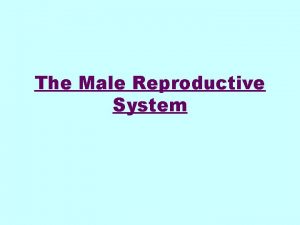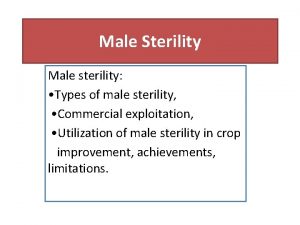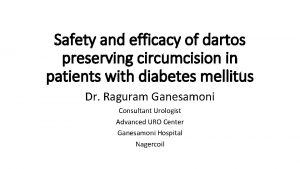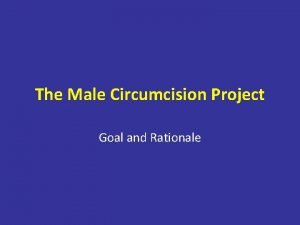Summarising Male Circumcision Efficacy Results of the three

















- Slides: 17

Summarising Male Circumcision Efficacy: Results of the three randomised clinical trials Neil A Martinson Perinatal HIV Research Unit

Three Randomised Control Trials of Male Circumcision • Orange Farm – South Africa • Kisumu – Kenya Feb 2007 • Rakai – Uganda Feb 2007 Today: Feb 2010 Nov 2005

Efficacy • How well an intervention works when studied in under rigorous conditions of a RCT. • Percentage reduction in disease events by providing the intervention. • Control group/arm– no circumcision • Intervention group/arm- circumcision (but in all other respects groups are v. v. similar)

Conditions of a trial • • Well funded Excellent staff – trained and supervised Adverse events reported immediately Monitors – oversee every aspect of the trial • • Participants in trial ≠ general population Numerous: visits, samples, questions No visit – immediately triggers retrieval More attention than real life (safe sex).

Answers of a trial Under “ideal” conditions • Is circumcision better than not circumcising? • If better, by how much? • Is it safe?

Trial jargon • Male circumcision – removal of virtually all penile foreskin by a trained health worker using sterile surgical techniques. • Randomisation: Subjects allocated to intervention or control group by chance (but in equal numbers). • HIV acquisition: becoming infected with HIV • Adverse event: unwanted side effect of intervention

The three studies: design HIV negative men Randomised Circ No circ Follow up 6 mo Follow up 12 mo Follow up 18 mo Final HIV Assessment @ 24 mo Circ

Results 1: Orange Farm Overall efficacy of male circumcision in preventing HIV acquisition by young men: 60% 3. 6% had an adverse event related to circ Auvert et al PLo. S Medicine 2005

Results 2: Rakai - Uganda Overall efficacy of male circumcision in preventing HIV acquisition: 55% 8% had adverse event related to circ. Time Circ group Uncirc group 0 -6 months 1. 2% 1. 6% 6 -12 0. 4% 1. 2% 12 -24 0. 3% 1. 2% ALL 0. 7% 1. 3% Gray et al Lancet 2007

Results 3: Kisumu - Kenya Overall efficacy of male circumcision in preventing HIV acquisition: 53% 1. 7% adverse events related to circ Time interval Circ group Uncirc group 0 -6 months 0. 8% 1% 6 -12 0. 2% 1. 4% 12 -18 0% 0. 7% 18 -24 1% 1. 2% ALL 2. 1% 4. 2%

Combining all 3 “ The results indicate compelling evidence that male circumcision, when conducted using a medical procedure, reduces the acquisition of HIV by heterosexual men by between 38% and 66% over 24 months. Incidence of adverse events is very low, indicating that male circumcision, when conducted under these conditions, is a safe procedure. “ Siegfried N et al Cochrane Database 2009

Benefits restricted to men! • A trial of circumcising HIV-infected men showed no reduction in HIV acquisition by female partners of circumcised men. • Those who resumed sex early were at higher risk of acquiring HIV from their male partner. Wawer M et al Lancet 2009

What else is there to prevent HIV? • Behaviour changes (ABC) – Condom use – Reduce concurrent partners – Delay sexual debut • • • Vaginal Microbicides Barriers (condoms and diaphragms) Vaccines Pre exposure prophylaxis Treatment as prevention

Thank you for your attention

ALVAC®-HIV (v. CP 1521) • Recombinant canarypox vector vaccine genetically engineered to express HIV-1 gp 120) subtype E: 92 TH 023) linked to the transmembrane anchoring portion of gp 41) subtype B: LAI), and HIV-1 gag and protease (subtype B: LAI). AIDSVAX® B/E • Bivalent HIV gp 120 envelope glycoprotein vaccine containing a subtype E envelope from the HIV-1 strain CM 244 and a subtype B envelope from the HIV-1 strain MN.


HIV Vaccine Acquisition Endpoint: Modified Intent-to-Treat (m. ITT) Placebo Vaccine infections: 51 Placebo infections: 74 p = 0. 04 Efficacy: 31. 2% 95% CI (OBF): 1. 1, 51. 2
 Circumcision
Circumcision Male circumcision
Male circumcision Male circumcision
Male circumcision Male circumcision
Male circumcision Summarising sheba
Summarising sheba Summarising sheba
Summarising sheba Summarising sentence starters
Summarising sentence starters Linking words summary
Linking words summary Summarising and paraphrasing
Summarising and paraphrasing To put it simply
To put it simply Why is summarizing important
Why is summarizing important Summarising learning intention
Summarising learning intention Difference between summarizing and paraphrasing
Difference between summarizing and paraphrasing Plotbox
Plotbox Disadvantages of circumcision
Disadvantages of circumcision Circumcision
Circumcision Circumcision
Circumcision God looks at the heart meaning
God looks at the heart meaning

